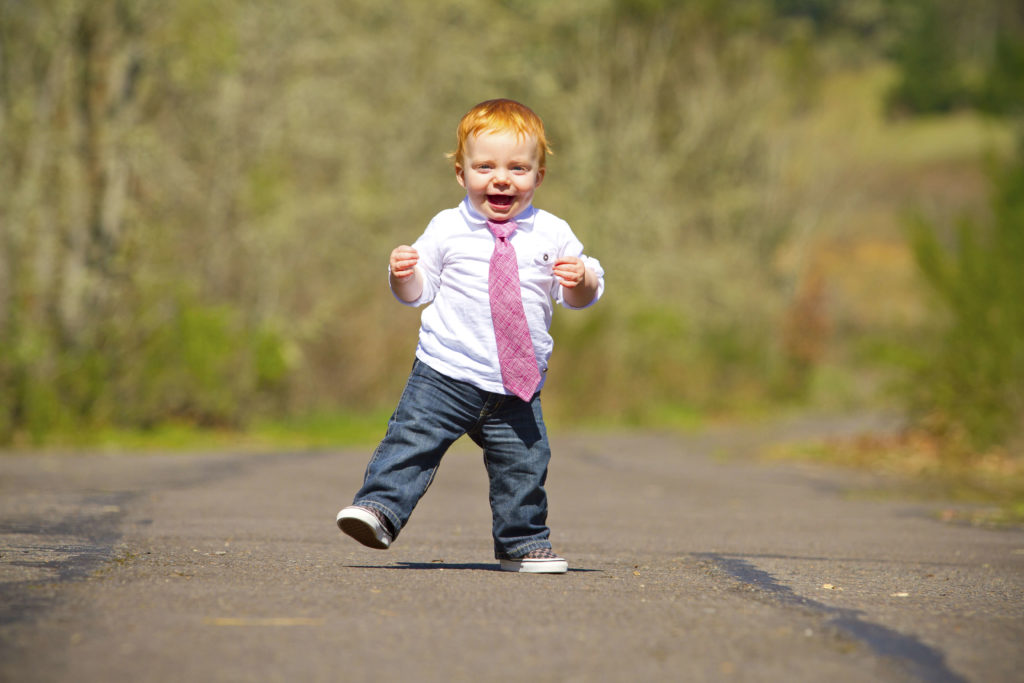Gross Motor Milestone Series: Walking

Prior to walking, your child should be able to pull to stand and lower to the floor independently without falling. He or she should be able to pick toys up off the floor and return to stand while holding onto a support surface and continue playing in supported standing indefinitely. Again, in order to move, your baby has to have the freedom to move. This means daily time spent on the floor outside of car seats, strollers, standers, swings, etc.
Cruising
Cruising activities help to build leg and lower back strength while working on balance.
- While standing and holding onto a piece of furniture, place a toy just out of the reach of your child and encourage them to go get the toy. To start, move the hands and feet one at a time in the direction of the toy. Practice going to both the right and the left. Gradually increase the distance your child has to cruise to reach the toy.
- Practice rolling a toy car along a low surface while walking.
- Work on cruising around corners to the right and the left.
- Practice walking sideways left and right while holding onto both of your child’s hands or while your child is holding onto a slowly moving toy, such as the side of a wagon.
- Progress to cruising at taller surfaces or by using a flat wall.
Standing
Independent standing demonstrates a child’s ability to keep their balance without support and shows adequate strength to maintain upright posture.
- Have your child stand while lightly holding on to their hands. Slowly release the support of one hand and practice maintaining balance. Start having your child reach for toys with the unsupported hand. Gradually decrease to one finger assist only.
- Complete the activities above with your child standing at a support surface.
- Have your child stand with his or her back against a couch or wall and reach for or play with toys.
Have your child stand on a stable floor and slowly release your support. Make sure that their feet are about shoulder width apart and that they are not leaning to one side or falling forward or falling backward you release your support. Be ready to catch them before they fall.
Walking
Walking is a lifelong motor skill that we use to access our environment, for recreation, and for exercise. It is a required prerequisite for advanced balance and coordination activities, such as running and jumping.
- Start practicing step taking while holding your child around the waist. Assist with weight shifting by leaning slightly to the side so that it is easier to un-weight the opposite foot and move it forward.
- Progress to holding onto both arms, then both hands, then one hand. Practice stepping on bubbles, bug stickers, etc.
- Have your child walk while holding onto a push toy. Weight the toy down to make it heavier so that it doesn’t get pushed too far in front.
- Hold a hula hoop or dowel and have your child walk while holding onto the other end.
- To progress independent steps, place toys on two support surfaces (such as a couch and a coffee table) so that your child has to move between the two to get their toy.
- To start, the support surfaces should be close enough together that no steps are needed but far enough away that they can’t touch both sides at the same time.
- Once your child is able to move easily between the two surfaces, gradually increase the distance between them until steps are required to get from one side to the other.
Once your child starts walking more than 5-10 steps, work on these activities:
- Walk to a toy, pick it up off the floor, and continue walking.
- Carry items of varying sizes from place to place.
- Walk around obstacles.
- Change directions. Start with small turns and work up to 180° turns.
- Walk over varying surfaces – hardwood, tile, carpet, grass, dirt, sand, etc.
If your baby isn’t walking alone by 16 months of age, they might benefit from a physical therapy evaluation. Contact MOSAIC Health & Rehab to schedule a free screen or to set up an evaluation. Check out Gross Motor Milestones: Jumping to learn what your child should develop next. To learn more, check out this great milestone moments list from the CDC.
